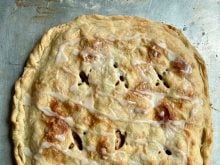“It must be tough parenting these days. I wouldn’t want to be doing it,” says one elder.
But a group of teens joined an intergenerational team to go to Louisiana to help repair homes in the flood damaged state, adds another.
These are two adult observations of the younger generation. One is expressing fear because there are so many things that can lead kids to trouble. The other is saying there are many examples of youths who help others and do good.
I view our teens as being a wonderful generation that is politically and socially aware of their world and ready to sacrifice their time and energy to help others.
Read Also

From farmer to award-winning distiller
Pivot Spirits showcases transition from farmer to distiller with provincial award-winning results in Alberta for Lars Hirch
Recently, some teens from the Herschel and Fiske, Sask., Mennonite churches joined with family and neighbours to travel to Louisiana to help repair homes. Another group of youth and adults from the Rosetown, Milden, Kyle, Lanigan and Beechy, Sask., communities and churches travelled to the Vincente Guerrero area in Mexico to build a home, repair an orphanage and run a vacation Bible school.
Last fall, Jenny Pearson, a Grade 12 student at Bishop James Mahoney High School in Saskatoon, was moved by the devastation caused by hurricane Katrina in New Orleans. She had recently visited her aunt and uncle there and they had given her some Mardi Gras beads. Following the hurricane, her aunt and uncle sold their Canadian home to return to New Orleans to help their neighbours. Jenny decided to also help by selling Mardi Gras beads to her fellow classmates to raise money for the hurricane victims. The students responded by purchasing almost 2,000 strings of beads, raising close to $3,000.
One fact that comes through in these examples is the role of significant adults and church communities in the youths’ lives. These adults and churches have encouraged, mentored or worked with the youth and have given them an example of serving and caring for others.
I was at a drug information meeting recently. One of the chilling facts given was that many children are introduced to illegal drugs by someone they know such as an older sibling, cousin, aunt or parent.
These examples illustrate the fact that young people are influenced by what adults tell and show them both positive and negative by their lifestyle choices and habits. Something as small as a brief chat and encouraging word with the teen that carries out your groceries can have an influence in their life.
Multiple batches
Dear TEAM: In your Jan. 12 paper there was a recipe for taco mix. I thought I would send in this recipe because it makes more than one batch. I serve it with nachos or other kinds of chips, lettuce, chopped tomatoes, chopped green pepper, shredded cheese and sour cream on top. It tastes good. – H.W., Bashaw, Alta.
Taco seasoning mix
2 tablespoons chili powder 30 mL
5 teaspoons paprika 25 mL
41/2 teaspoons ground cumin 22 mL
1 tablespoon onion powder 15 mL
1 tablespoon salt 15 mL
21/2 teaspoons garlic powder 12 mL
1/8 teaspoon cayenne pepper 0.5 mL
Mix these and shake together. Store in a spice jar for up to six months.
Additional ingredients
1 pound ground beef 500 g
2/3-3/4 cup of water 150-175 mL
6-8 teaspoons taco 30-40 mL
seasoning mix
Cook beef and drain. Add water and taco seasoning. Bring to a boil. Reduce heat and simmer uncovered 10 minutes. Serve on chips.
Yields four servings.
The seasoning mix will make enough for five to six batches of the ground beef mixture.
More seasoning
Dear H.W.: Thank you for your version of this recipe. Here are seasoning mixtures from Atco Blue Flame Kitchen cookbooks. They are applied to food to flavour it before grilling. Pat the rub firmly onto the surface of the food to ensure the seasonings in the rub will adhere well.
Madras rub
1/4 cup sugar 60 mL
2 teaspoons paprika 10 mL
1 teaspoon curry powder 5 mL
1 teaspoon freshly ground pepper 5 mL
1/2 teaspoon salt 2 mL
1/4 teaspoon cayenne pepper 1 mL
Combine all ingredients. Store in an airtight container in a cool dry place. Makes 1/3 cup
(75 mL).
Reunion rub
1/3 cup paprika 75 mL
1/3 cup garlic powder 75 mL
2 tablespoons oregano, 30 mL
crumbled
2 tablespoons thyme, crumbled 30 mL
2 tablespoons onion powder 30 mL
2 tablespoons pepper 30 mL
2 tablespoons salt 30 mL
1 tablespoon cayenne pepper 15 mL
Combine all ingredients in a blender. Store in an airtight container in a cool dry place. Yields 11/3 cups (325 mL).
Ordering corn seeds
There are many kinds of corn seeds listed in the seed catalogues and for sale at the seed stores. Which one to buy?
According to The Gardener for the Prairies magazine, the type of corn gardeners plant will depend on their final goal. If they are looking for corn that may not produce the best quality cob but will produce corn in a cooler environment with a shorter season, a normal sugary type might be the best choice. If they have a longer season and sweetness is the goal, a supersweet or triplesweet would be the best choice.
Normal sugary was the standard type used for sweet corn for many years. It is easy to grow, although it is not the best quality sweet corn. When the cobs mature, the sugar in this type of corn converts to starch quickly, so its harvest window is only one or two days. It is best eaten immediately after picking.
Sugar enhanced varieties are usually easier to grow than supersweet and triplesweet because they need fewer heat units to produce mature cobs. It is sweeter than normal sugary but not as sweet as the supersweet varieties. The kernels are more tender than all other corn types.
Supersweet has a sweeter flavour and higher quality compared to normal sugary type corn. The varieties have a slow sugar to starch conversion and so have a longer shelf life
and a longer harvest window.
Triplesweet is the latest corn-breeding innovation. It combines the sweetness of the supersweet with the tenderness of the sugar enhanced for a superior quality corn.
Buckwheat source
Dear TEAM: I would like to find a supply of buckwheat husks to make some of those buckwheat pillows that were popular recently. I can’t find any and I would like to make some as gifts. – E.L., Runnymede, Sask.
Dear E.L.: I wasn’t able to locate a store that sells buckwheat husks but I did find a couple of websites. This one at www.buckwheatpillows.biz. gave Canadian prices and shipping so you can have them sent directly to you. The site sells organic bulk buckwheat hulls by the pound as priced below. Buckwheat hulls are also called buckwheat husks.
The bulk buckwheat hulls it sells are certified organic and are double cleaned and sifted. This means that buckwheat dust and broken hulls are kept to a minimum.
The hulls are also flattened rather than crushed. Crushing breaks the hulls, reducing their usefulness and life.
As well, they claim their buckwheat hulls
are stored in dry conditions at room temperature, unlike cheaper imports that have been fumigated, may be full of broken pieces and dust, and have been sitting in warehouses and on ships for weeks or months.
I use a buckwheat husk pillow and love it. I do suggest a second zippered cover over the original pillow, and then a pillowcase. I have had the unfortunate experience of the pillow opening and discovering a pile of buckwheat husks in the morning.
To make a small pillow 14 x 20 inches
(35 x 50 cm) you will need about four pounds (two kg); a larger pillow 17 x 23 inches
(43 x 58 cm) requires six lb. (three kg). If you want overstuffed pillows, add one pound
(500 g) to these numbers.
The prices in pounds for buckwheat hulls:
One to five pounds, $6.96 Cdn including GST per lb. (plus shipping).
Six to 10 pounds, $5.35 Cdn including GST per lb. (plus shipping).
Standard service shipping is two to three weeks. The cost of under $20 ordered is $4.95; and $6.95 for a $20.01 to $50 order.
Airmail service (seven to 10 days) is an additional $7.95 to the above shipping rates.
Betty Ann Deobald is a home economist from Rosetown, Sask., and one of four columnists comprising Team Resources. Send correspondence in care of this newspaper, Box 2500, Saskatoon, Sask., S7K 2C4 or contact them at team@producer.com.














